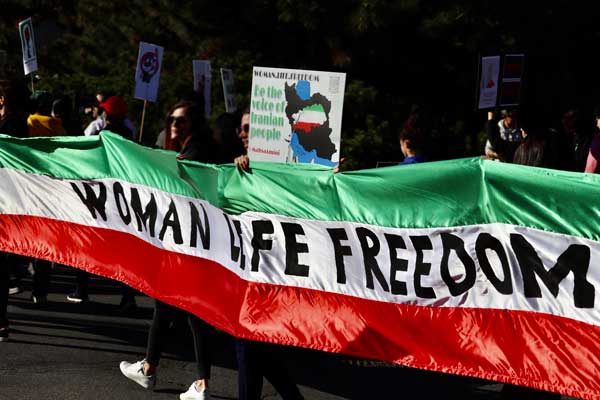Is The “Woman, Life, Freedom” Movement Inside Iran Our “Deep South”?
By Hooshyar Afsar
It may sound far-fetched to many, yet there are clear similarities between how the American Civil Rights movement in the 1950s and 1960s overcame seventy years of Jim Crow segregation in the United States and what we Iranians are engaged with inside and outside Iran today with regards to the “Woman, Life, Freedom” movement. To elaborate, we first need to do a quick recap of history so that the reader understands the historical context.
A Brief Recap of History
After four years of a bloody Civil War, the Southern rebel states who had committed treason against the constitution of the United States by seceding from the Union in 1861, with the intention of continuing to enslave people of African descent for economic gain, were defeated in 1865. What followed was a revolutionary period of 12 years during which—with the heroic endeavor of Black Americans in both the South and the North and with the support of progressive whites—the 13th, 14th, and 15th constitutional amendments were passed in the United States, through which slavery was pronounced illegal, former enslaved people and everyone who was born on the soil of the United States were recognized as citizens, and the rights of all men (regardless of their race or national origin) were recognized to vote and be elected. This ended 250 shameful years of slavery and the right of “life, liberty and pursuit of happiness,” as espoused by the nation’s founders in the Declaration of Independence, finally looked to be a promise to all its citizens (well, the male ones anyway). This era was so revolutionary and earth-shattering that the socio-political movement it caused is called “The Second Founding” by many historians. (1)
Then came the shameful Compromise of 1877, in which the victory in the contested presidential election of 1876 was handed to the Republican Rutherford B. Hayes and, in return, Republicans agreed to remove the Union troops from the Southern states. This left Southern Blacks and progressive whites unprotected, facing the “redeemers” who wanted to reestablish a new system of racial control. The white supremacists in the South, i.e., many of the enslavers of the past and officers of the rebel army of the South, were able to to push back the gains of Black people and progressive whites in the South. The social trauma of hundreds of years of enslavement was continued in new, systemically racist ways.
This protracted and reactionary effort culminated in the establishment of a segregationist and terroristic regime in the Southern states known as “Jim Crow,” beginning with the passage of the Mississippi constitution of 1890. This first segregationist state constitution, for all intents and purposes, made Black Americans second class citizens and took away their right to vote. All other Southern states soon followed Mississippi with passage of their own “Jim Crow” constitutions. In the years that followed, the Supreme Court of the United States put its stamp of approval on the constitutionality of segregation with its ruling for the segregationists in the landmark case of Plessy v. Ferguson.
The system of racial segregation in the South was not just about demoting Black people to second class citizen status under the lie of “separate but equal,” but it was a full fledged regime of terror against Black Americans in the South. According to the landmark report of the Equal Justice Initiative on lynching, first published in 2015, between the years of 1877 and 1950 the racist “Jim Crow” terror in eleven Southern states resulted in over 4,000 documented cases of lynching. (2) The terror had a clear aim of keeping Black people economically, socially, and politically disenfranchised. While many Black families attempted to migrate out of the South, there were not that many jobs for them in the North since racism was also very strong in the industrial North and even in the workers trade unions dominated by whites. The Northern industrial cities satisfied their need for low wage labor by using the cheap labor of new migrants from Europe.

And then, World War I broke out in Europe in 1914. Immigration to the United States plummeted and there was a labor shortage in the North. This process facilitated what is known as the Great Migration. From 1915 to 1970, six million Black Americans left the Southern states for the Northeast, Midwest, and even the West, the single largest migration of the country’s citizens within its own borders. (3)
The Great Migration had a profound cultural, social, and political impact on the United States. While Black people in the big cities of the Northeast, Midwest, and West were still subjected to “James Crow” racism, they had better jobs, better opportunities for their children’s education, and the right to vote. In the cultural scene, this ushered in a new era of amazing creativity in literature, music, and the arts that completely transformed American culture. Literary giants such as James Baldwin, Langston Hughes, and Tony Morrision came out of this era. Jazz and other musical genres were directly impacted or were rooted in the migrants who came out of the South. Professional athletes who broke and held records for decades in many sports were from families who had dared to migrate amid the terror in the South.
So when the American Civil Rights movement went into a high momentum phase after the Supreme Court’s Brown vs. Board of Education ruling (deeming “separate but equal” educational spaces unconstitutional) and Rosa Parks’s action that led to Montgomery Bus Boycott in the 1950s (social protest of the segregation policies in public transit), Black intellectuals who had emerged from the Great Migration and didn’t live in the South played an important role.
The question facing the movement hinged on the roles of the Black activists or intellectuals who lived outside the segregationist South as compared to those of the activists who were protesting in the streets of cities like Birmingham, Selma, and Montgomery (among others) and who were actively subject to police brutality and white supremacist/KKK terror. Who would play the main role? Civil rights icons like W.E.B Dubois had emphasized the main role of the South in the past. Yet, this time, one woman made a crucial difference.
The Little Big Woman!
In May 1963, Birmingham, Alabama, deep in the deep South, was a major hotbed of civil disobedience action facing police brutality and KKK racist aggression. The Kennedy Administration, which had not yet taken a decisively supporting position on the movement, wanted to quell the Black population in Birmingham. So, JFK’s brother, Robert Kennedy (RFK), who was also the Attorney General, was given the task to meet with a representative group of the movement in a quiet fashion in a Kennedy-owned apartment in Manhattan. As professor Imani Perri of Princeton writes in her book, present were a “who is who” of the Black writers, musicians, and other intellectuals of the time, including the immortal James Baldwin, Harry Belafonte, Dr. Martin Luther King Jr.’s advisor, and a 33-year-old activist playwright whose play, “A Raisin in the Sun,” had already gained her international fame. (4) Her name was Lorraine Hansberry, a tiny person with a large presence. Present also was a young “Southern freedom movement orga-nizer Jerome Smith. Smith had founded the New Orleans chapter of the Congress of Racial Equality (CORE) and had initially come to New York so that doctors could attend to the jaw and head damage he’d sustained from beatings at the hands of Southern cops.” (4)
According to Baldwin, the meeting began quietly, yet Jerome, with a jaw still healing from the injuries incurred by the Southern police, started to challenge RFK, stating that the federal government was insincere because it was not really protecting the protesters in the South—and, specifically, in Birmingham—because the protestors were left alone facing police brutality. RFK completely ignored Jerome, which is when Lorraine stood up and said: “‘You have a great many very accomplished people in this room, Mr. Attorney General, but the only man you should be listening to is that man [Jerome Smith] over there. That is the voice, she added after a moment during which Bobby Kennedy sat absolutely still staring at her, of twenty-two million people.” And then she said, “We would like, from you, a moral commitment,” before walking out from the apartment with most of the attendees following her.
About the aftermath of the meeting, Perri writes: “Though RFK was reported to have considered the meeting a great waste of time, less than one month later, his brother President Kennedy, at RFK’s urging, gave his landmark civil rights address during which he proposed the legislation that would be known as the Civil Rights Act of 1964. In the address, JFK spoke of civil rights as not just a legal issue but also, as Lorraine said, a moral one.” (4)
Historic Lesson
The role of the Iranian diaspora in the “Woman, Life, Freedom” movement has similarities with what was discussed above. Although it is not a one-to-one comparison and there are clear differences between the Great Migration and the over six million Iranians who have emigrated from Iran in the last four decades, similar discussions are going on in this movement regarding who should lead the movement and who shall determine the outcome. There are overt and covert efforts to hijack the movement from abroad by certain political forces that avoid using the main slogan of “Woman, Life, Freedom” and have attempted to put their own stamp on the movement.
We know that giving a “moral commitment” to the Civil Rights movement and the Black people fighting on the streets in the deep South by the Kennedy Administration made a significant difference in the final collapse of “Jim Crow” segregation. One could argue that the lesson we learn today from the words of Lorraine Hansberry, in that historic meeting that was seemingly a “waste of time,” is that dismantling the Islamic Republic’s gender apartheid system and establishing a secular and democratic Iran could only happen by the people inside Iran and especially the women leading the “Woman, Life, Freedom” movement. We have yet to find our Lorraine Hansberry, to put the men who would like to hijack and tame the “Woman, Life, Freedom” movement under their own “leadership” in their place. Yet, we could definitely learn from her: what the Iranian diaspora and the international community could provide is a “moral commitment” to support the movement to the end. That is the invaluable lesson of the Civil Rights movement for our Iranian communities around the world.
References:
(1) Foner, Eric, The Second Founding, W.W. Norton & Company (2019).
(2) https://eji.org/reports/lynching-in-america
3) Wilkerson, Isabel, The Warmth of Other Suns: The Epic Story of America’s Great Migration Paperback, Random House (2011).
(4) Perri, Imani, Looking for Lorraine: The Radiant and Radical Life of Lorraine Hansberry, Beacon Press (2018).


















